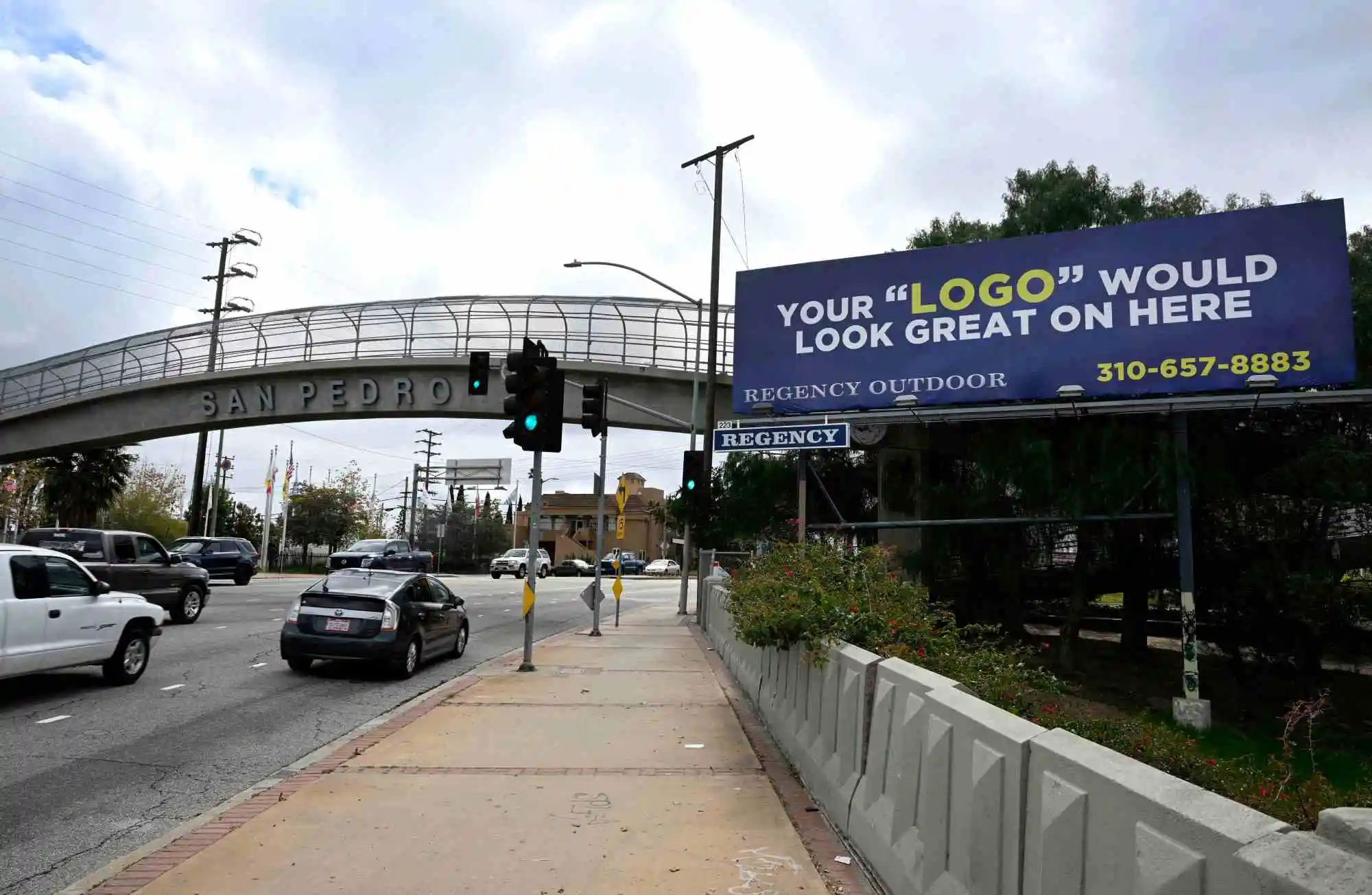
By Cassian Fernandez, Hunter Gibbs, and Paula Guarderas
After decades of waiting, citizens of San Pedro, CA, will soon see the removal of a giant billboard from the city entrance.
The San Pedro neighborhood in Los Angeles is full of museums, craft breweries, and white sand beaches. One of the town’s main access points at North Gaffey Street is adorned by an underpass painted with “Welcome To San Pedro.”
Directly to the right, however, obscuring half of the landmark, is a giant billboard that has advertised everything from doctors to high schools to anti-masking initiatives.
For decades, people entering San Pedro at the end of the Harbor Freeway would receive the friendly underpass welcome message, only to be immediately slapped in the face by Regency Outdoor Advertising’s billboard, which had been described by many as “monstrous.” Not only for its size, rivaling that of San Pedro’s monument sign, but because of its imposing and distracting presence, which has caused traffic accidents.
According to Los Angeles Councilmember Tim McOsker, who represents Council District 15, residents of San Pedro have been working since the start of the millennium to have the billboard removed. Even his predecessor, Joe Buscaino, considered the billboard to be an “unholy sight” and a “thorn at [his] side.”
The billboard’s lease expired in December 2022, almost seven years after LA city officials approved the purchase of the underlying land. Two months later, after Regency had failed to respond to repeated notices to vacate the property, city officials filed a lawsuit against Regency. The billboard placed an ad the same week they were sued.
On February 22 of this year, Regency responded in a press releasethat it had “responsibly operated billboards in Los Angeles and Greater Los Angeles to the highest standards,” using as examples its “millions of dollars in public benefit and donations to many public causes that both benefit the City and Southern California and its citizens, and help keep [their] community safe.”
Although, during the past few years, the billboard has displayed various messages, covering everything from retirement community advertisements to slogans opposing mask mandates.
Regency even attempted to negotiate an agreement that included revenue sharing, offering public benefits through beautification and a new public park, electronic vehicle charging, and a new city welcome sign with a dedicated digital display, public messaging, plus power generation and storage.
The City of Los Angeles ignored these requests, as the desires of the citizens of San Pedro were clear. The eviction process proceeded.
Billboard removal was originally slated to begin late-June, but was delayed nearly a month due to permitting and scheduling issues. Then, seven months after the billboard’s lease expired, it would finally be taken down. McOsker was pleased to see that a community could come together and, in his words, “fight back against a big multi-billion-dollar Goliath and actually win.”
At the request of the citizens of San Pedro, Regency was to hire a private firm to remove the billboard, instead of utilizing city employees. On July 18, the three-day removal process was ceremoniously kicked off by a speech made by McOsker at a spontaneous community gathering on the nearby footbridge.
According to the Daily Breeze, shortly after McOsker’s remarks, the crane hired by Regency to remove the billboard collapsed. The two workers in the crane fell nearly 20 feet to the ground and sustained non-life-threatening injuries, according to LAPD Sgt. Juan Terrazas.
Although the billboard removal process is temporarily halted, city officials intend to further enhance the appearance of the pedestrian bridge linking the Barton Hill and Peck Park neighborhoods once the billboard finally comes down.
As of July 21, Regency had yet to answer questions about the incident.
Billboards impose multifaceted harms on the communities in which they are installed. They are considered by many to be the ultimate form of scenic blight and visual pollution, obscuring nature and the community’s scenic beauty.
Visual pollution is directly linked to widening socioeconomic divides by devaluing properties in lower-income communities, where there are less galvanized efforts for removal. A 2011 University of Pennsylvania study by urban planner Jonathan Snyder, Beyond Aesthetics, showed that homes located within 500 feet of a billboard are worth $31,000 less at the time of sale than those located further away.
They also harbor significant road safety concerns, specifically digital billboards. A 2015 government-funded study on the impact of digital billboards along high-speed roadways in Alabama and Florida found crash rates 25 percent to 29 percent higher near the signs than at control sites down the road, with distractibility comparable to cell phones.
Lastly, it’s important to consider ecological disturbances. In 32 states, billboard companies are legally permitted to cut and remove publicly owned trees in order to make their signs more visible. Removal of these highway buffer trees contributes to erosion and negatively impacts air quality. Surrounding neighborhoods and property owners suffer from increased noise and light pollution.
Here’s what YOU can do to keep billboards out of your neighborhood:
- Sign our petition to help us fight the blight!: Sign Our Petition to Stop Digital Billboard Blight (salsalabs.org)
- Submit public comments and attend city council meetings, especially for billboards that have extended their
- If applicable, join your local chapter of Scenic America.
- Create a community action plan.
- Host focus groups analyzing the issue at hand.
- Gather data.
- Research previous
- Convene planning group.
- Develop action plan.